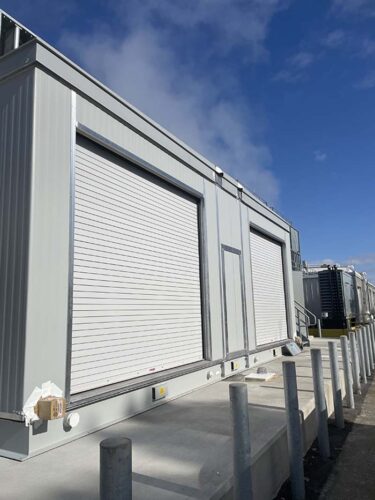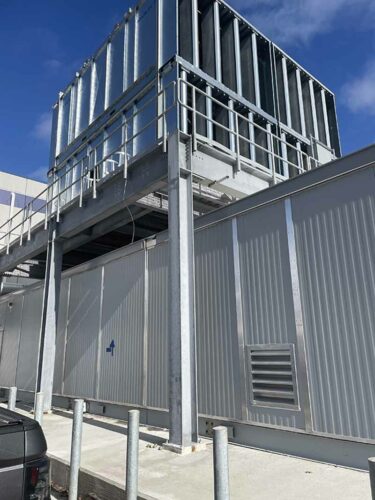The HVAC industry is undergoing many changes — some perpetuated by the burgeoning of modular construction and prefabrication as a whole. Whether you’re an HVAC professional or a commercial facility manager looking to upgrade your systems, understanding these methods will help you make informed decisions.
This blog will explore the nuances of modular construction and prefabrication in the HVAC industry, illuminate their key differences, and weigh their benefits and drawbacks. We’ll also look at real-world applications and discuss actionable insights on which approach may be right for you.
Introduction to Modular Construction and Prefabrication in the HVAC Industry

Both modular construction and prefabrication have seen a rise in the HVAC industry in recent years. You may have even heard these words used interchangeably — but they are anything but. These methods promise faster installation, cost savings, and enhanced quality control. But what exactly do they entail?
Prefabrication refers to manufacturing specific components or sections of HVAC systems in a controlled environment and then transporting these components to the site for assembly as a whole. Prefabrication would be used for floor sections, cabinets, doors, windows, and more; these would be made in a factory, as it simply was not cost-efficient to make on-site. In the grand scheme, prefabrication focuses more on individual parts rather than whole units.
Modular Construction, on the other hand, is actually one type of prefabrication, and involves assembling, parts of/whole buildings and HVAC systems in modules or sections off-site. These modules are then transported and installed at the final location. Think of this process as like building with LEGO pieces — each module is a self-contained unit that fits seamlessly with others.
Both methods aim to streamline the building process and improve the efficiency of HVAC installations. But how do they differ, and what unique advantages do they offer? Let’s find out.
Understanding the Key Differences between Modular and Prefabricated HVAC Systems
Though often used interchangeably, modular construction and prefabrication have distinct characteristics. Here’s a closer look at their key differences:
Scale and Scope
Modular construction is typically more comprehensive. It involves creating entire sections of HVAC systems off-site, which can significantly reduce on-site labor and installation time.
With Donnelly overseeing the Northwell Modular Construction project, our team visited Carrier’s North Carolina facility to get a firsthand look at the 19MV Centrifugal Chiller. This chiller will ultimately be delivered to Systecon’s production floor in Ohio to be manufactured alongside the rest of the Central Utility Plant, which will ultimately be installed at the Pavilion at Northwell’s South Shore University Hospital.
While this is a form of prefabrication, prefabrication itself focuses on smaller and specific components like ducts, pipes, or electrical panels, which are then assembled on-site.
Design Flexibility
Modular systems offer limited flexibility in design since modules need to fit together precisely. Once designed, changes become difficult and costly. Prefabrication, however, allows for more adaptability during the assembly process, enabling easier modifications if necessary.
Installation Speed
Both methods speed up the installation process, but modular construction tends to be faster. Since modules are pre-assembled and pre-tested, they can be installed quickly on-site. Prefabrication speeds up specific aspects of the installation but may require more time for on-site assembly compared to modular systems.
Understanding these differences is crucial for businesses looking to choose the right method for their HVAC needs. But what about the pros and cons of each approach?
Benefits and Drawbacks of Modular Construction for HVAC

Modular construction offers several compelling benefits for the HVAC industry, but it’s not without its challenges. Here’s what you need to know:
Benefits of Modular Construction
- Time Efficiency: Since modules are constructed off-site and can be installed quickly, this ultimately reduces overall project timelines. Cutting the commute time for workers to travel on-site to construct said modules also improves productivity, as it allows for workers to thrive in better conditions.
- Quality Control: Building in a controlled environment ensures consistent quality and reduces the risk of on-site errors.
- Reduced Labor Costs: With much of the work done off-site, on-site labor requirements are significantly lower, leading to cost savings.
- Improved Safety: Modular construction reduces the amount of on-site work, leading to fewer safety hazards and disruptions.
Drawbacks of Modular Construction
- Design Limitations: Once modules are designed, making changes is costly and complex, limiting flexibility. It is worth noting, however, that modules are designed with disassembly and relocation in mind.
- Transport Challenges: Transporting large modules can be logistically challenging and may incur additional costs. It is essential to plan for this before beginning transport.
- Initial Investment: The upfront costs for modular systems can be higher, though they often lead to long-term savings.
These factors make modular construction an attractive option for many, but it’s essential to weigh the benefits against the potential drawbacks.
Benefits and Drawbacks of Prefabrication for HVAC
Prefabrication has similar advantages to modular construction, but other disadvantages worth exploring. Here’s a closer look.
Drawbacks of Prefabrication
- On-Site Assembly: While components are pre-made, considerable on-site assembly is still required, which can extend project timelines.
- Limited Scope: Prefabrication focuses on specific components rather than entire systems, which may not be suitable for all projects.
- Stability Differences: Since prefabrication works on a limited scale, the stability of prefabricated buildings may differ from modular ones.
Future Trends and Innovations in Modular and Prefabricated HVAC Systems
Increased Adoption of Smart Technologies
Smart HVAC systems that integrate IoT (Internet of Things) devices are becoming more prevalent. As previously discussed in our Building Management Systems blog, these systems offer real-time monitoring and adjustments, allowing commercial business owners in NYC to spot potential HVAC failures before they occur, while also leading to improved energy efficiency and user comfort.
Sustainable and Eco-Friendly Solutions
Sustainability is a growing focus in all sectors of industry, including HVAC. Innovations in modular and prefabricated systems are emphasizing eco-friendly materials and energy-efficient designs. These advancements are not only environmentally responsible, but also cost-effective in the long run and help you comply with Local Law 97’s increasingly stringent regulations.
Conclusion Which Approach Is Right for You
Choosing between modular construction and prefabrication for your HVAC needs depends on several factors, including your project’s scope, timeline, and budget. Both methods offer unique advantages and can significantly enhance the efficiency and quality of HVAC installations.
Regardless of the method you choose, the key is to stay informed and consider the specific needs of your business. As seen through our proactive measures with Systecon, Donnelly Mechanical remains committed to the forefront of HVAC innovation — so if you are looking to have prefabrication or modular construction work done, look no further than NYC’s leading HVAC service provider for over 30 years. To get started, please visit our website and call us today at 718-865-2294.